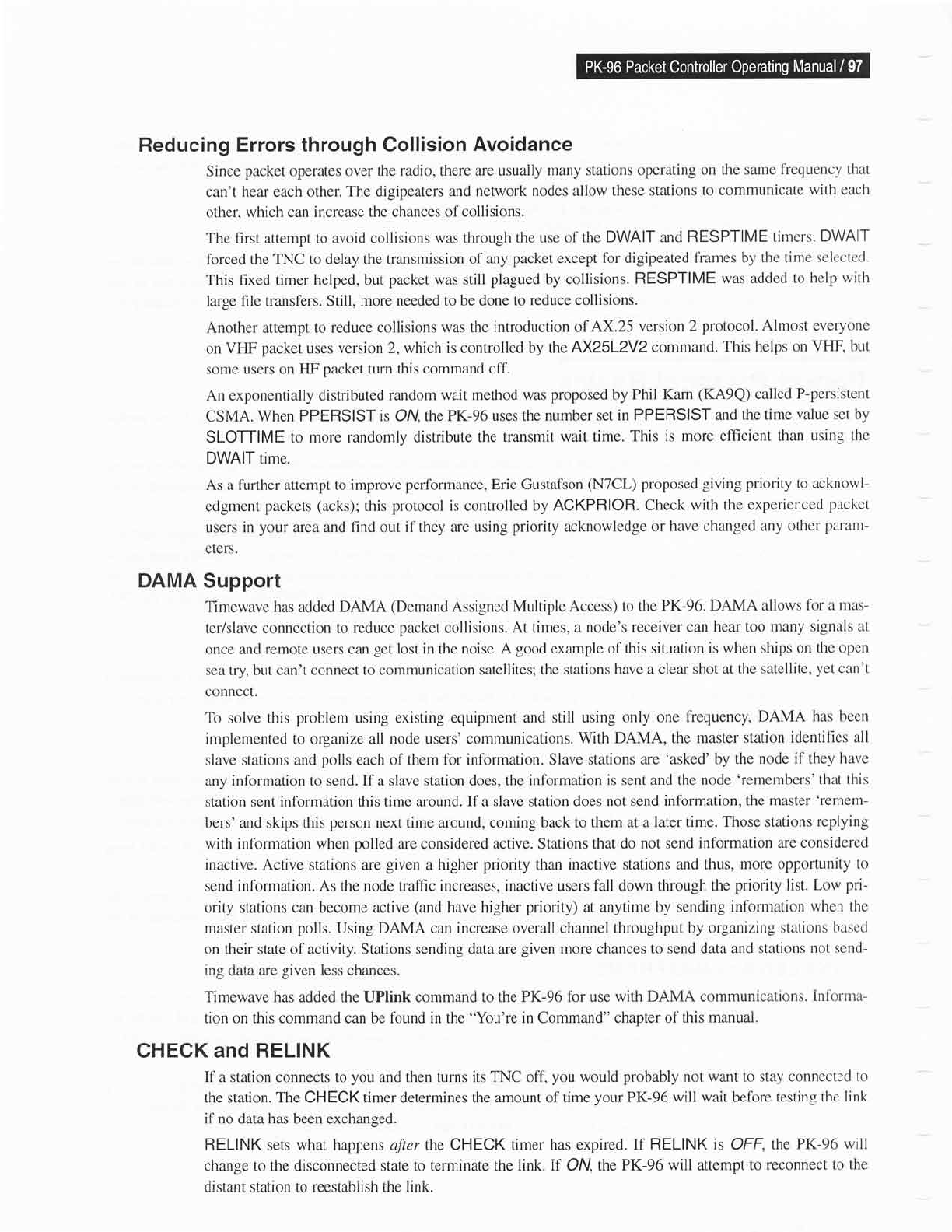Specifications
Table Of Contents

Reducing
Errors through Collision
Avoidance
Since
packet
operates over
the radio, there are
usually many
stations operating
on the same
frequency
that
can't hear each other.
The digipeaters
and network
nodes allow these stations
to communicate
with each
other,
which can
increase the chances of collisions.
The first
attempt
to avoid collisions
was through the
use of the
DWAIT and
RESPTIME timers.
DWAIT
forced the TNC
to
delay
the transmission
of any
packet
except
for digipeated
frames
by the time
selecLcd.
This
fixed
timer
helped, but
packet
was still
plagued
by
collisions.
RESPTIME
was added
to
help with
large file transfers. Still,
more needed to
be
done
to
reduce collisions.
Another attempt
to reduce collisions
was the introduction
of AX.25
version
2
protocol. Almost everyone
on VHF
packet
uses version
2, which
is controlled by the
AX25L2V2 command.
This helps on
VHF, but
some users on
HF
packet
turn this command
off.
An exponentially
distributed random
wait method was
proposed
by Phil
Kam
(KA9Q)
called
P-persistent
CSMA.
When PPERSIST is OM the
PK-96 uses the
number set in
PPERSIST and
the time
value set by
SLOTTIME to
more randomly distribute the
transmit
wait time. This
is more efficient
than
using the
DWAIT time.
As
a
further
attempt
to improve
performance,
Eric Gustafson
(N7CL)
proposed
giving priority
to acknowl-
edgment
packets
(acks);
this
protocol
is controlled by
ACKPRIOR. Check
with the
experienced
paokct
users
in
your
area and find out if they are
using
priority
acknowledge
or
have changed
any other
param-
eters.
DAMA
Support
Timewave
has added DAMA
(Demand
Assigned Multiple Access) to
the PK-96.
DAMA allows
fbr a mas-
ter/slave connection to
reduce
packet
collisions.
At times, a
node's receiver can
hear too many
signals at
once and remote users can
get
lost in the noise. A
good
example
of this situation
is
when ships on
the open
sea try, but can't connect to communication
satellites; the
stations have
a clear shot
at the satellite,
yet
can't
connect.
To solve this
problem
using existing
equipment and still
using only one
frequency, DAMA
has been
implemented to organize all
node users' communications.
With DAMA, the
master station
identifles all
slave
stations and
polls
each of them
for infbrmation. Slave stations
are
'asked'
by
the node
if they have
any
information
to send.
If a slave station does, the
information is sent and the
node
'remembers'
that this
station sent information this time around. If a slave
station does not send
information, the
master
'remem-
bers' and skips this
person
next time around, coming back
to them at a
later
time.
Those stations
replying
with infbrmation when
polled
are considered active. Stations
that do not send information
are considered
inactive.
Active stations are
given
a
higher
priority
than inactive stations
and thus,
more opportlrnity
to
send infbrmation. As the node traffic increases, inactive users
fall
down
through the
priority
list.
Low
pri-
ority stations
can
become
active
(and
have higher
priority)
at anytime
by sending
information
when
the
master station
polls.
Using DAMA can
increase
overall channel
throughput by organizing
stations
based
on their
state
of
activity. Stations
sending data are
given
more chances
to send data
and stations
not send-
ing
data are
given
less chances.
Timewave has added the UPlink command to
the PK-96 fbr use
with DAMA communications.
Infbrma-
tion on this command can be fbund
in
the
"You're in
Command"
chapter of this
manual.
CHECK and RELINK
If
a station connects to
you
and then turns its
TNC off,
you
would
probably
not want to stay connected
to
the
station. The CHECK timer
determines
the amount of time
vour
PK-96 will wait befbre testing
the
link
if
no
data has been exchanged.
REL|NKsetswhathappens afierthe CHECKtimerhasexpired.
If RELINKisOFF, thePK-96will
change to the disconnected state to terminate
the link. If ON, the
PK-96 will attempt
to reconnect
to
the
distant
station
to reestablish the link.










